
Today we're taking a closer look at the bamboo bases from the new Shrine Set, with a how-to guide on an easy way to create a thick bamboo forest for 28mm scale wargaming.
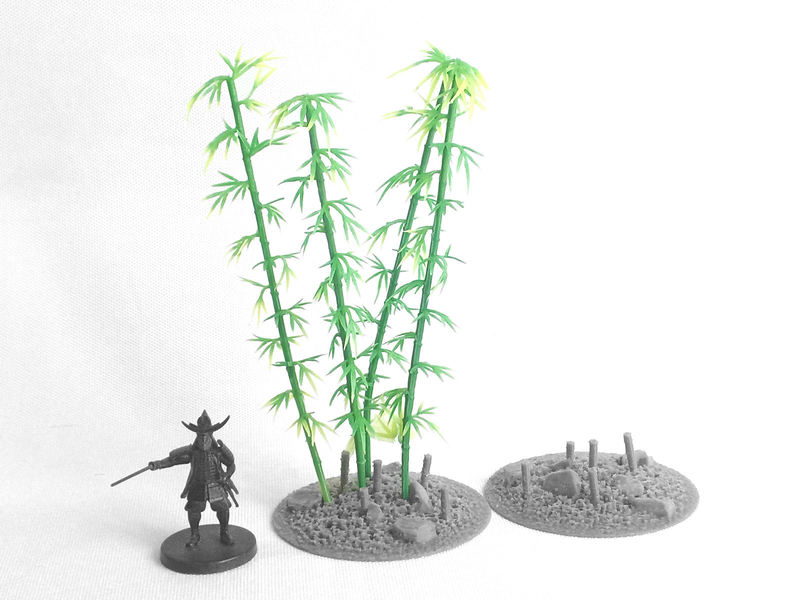
▲ This is a photo of the 60mm bamboo base included in the shrine set. As you can see, it's a simple textured circle, with a scattering of small rocks and broken shoots of bamboo. There's also a small hole in the underside for a magnet, in case you want to use that. These were printed at 0.2mm layers on an FDM printer, by the way.
The green bamboo trees are, of course, those bendy plastic ones you can buy in bulk online, and are not included in the print files.
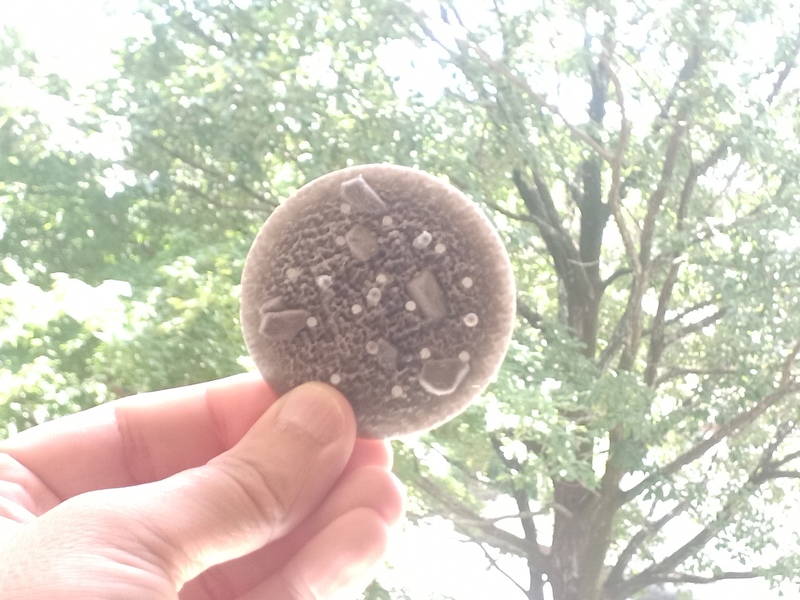
▲ To make attaching those green plastic bamboo trees to the printed base easier, there are fourteen small 2mm holes scattered around the base, as you can just about see in this photo. They are the light-grey dots, with the sunshine behind the thin plastic of the holes. Those are the perfect size for the bamboo tree stalks, with just a small blob of glue.
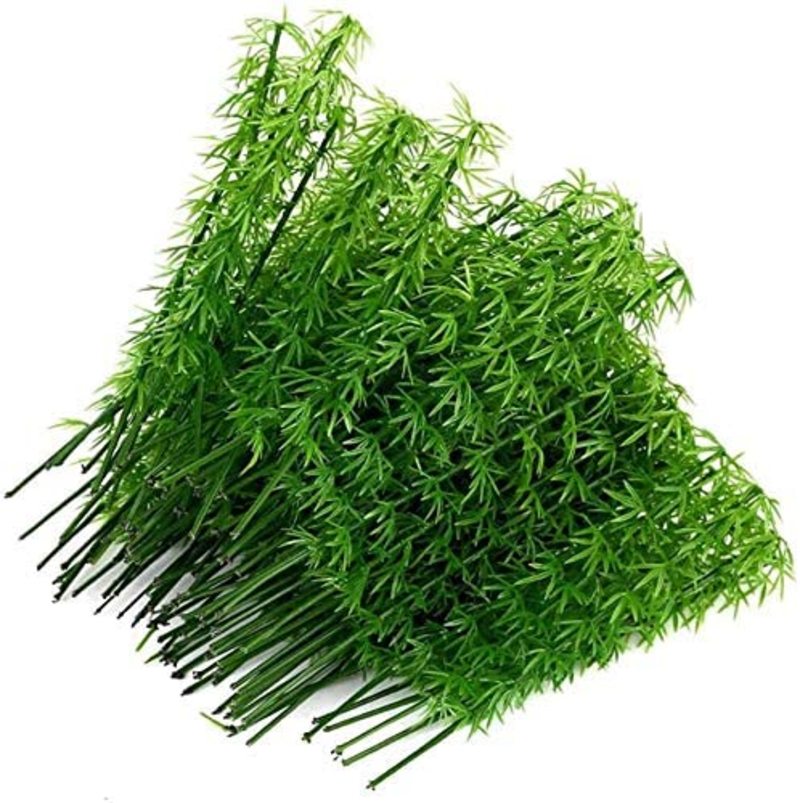
▲ I bought these cheap plastic bamboo trees from Amazon, for about $10 for 100 trees. I think they're actually advertised as 1:75 scale trees, about 12cm tall, but they'll work fine for 28mm (1:56) scale or even tall 15mm scale bamboo forests. I bought two packs of these, and printed 14 of the bases.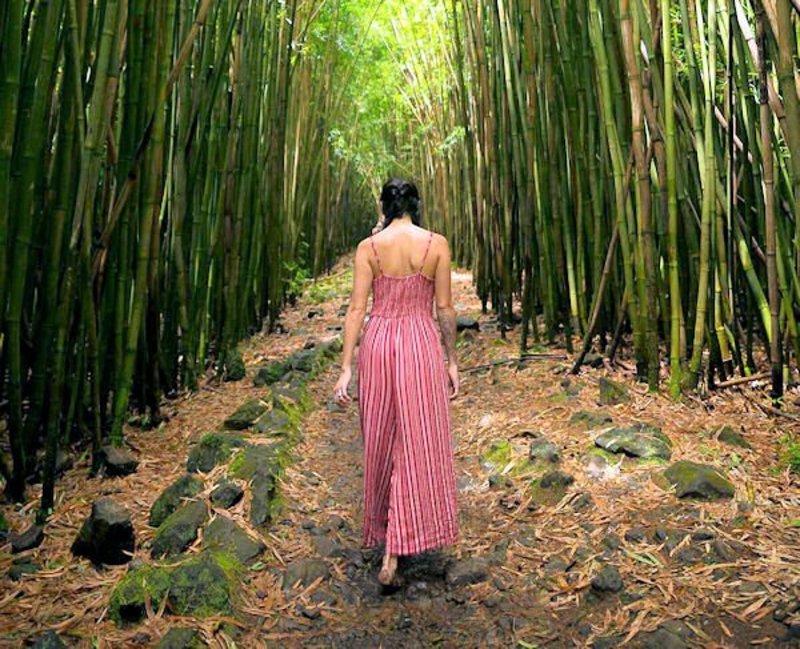
▲ Okay, now it's time to look at some reference photos. This is a bamboo grove in Kyoto, I think. You'll notice that the leaves on bamboo trees are actually only really found near the top half of each tree. As the tree grows taller, the bottom part (without leaves) stretches higher and higher.
If you take a look at the plastic trees I bought above, you'll see that the leaves start near the bottom of each tree, so it's probably going to look better to trim some of the lower leaves off.
The other thing you'll notice is the mass of brown leaf litter on the forest floor. I'm going to try to create that effect, too!
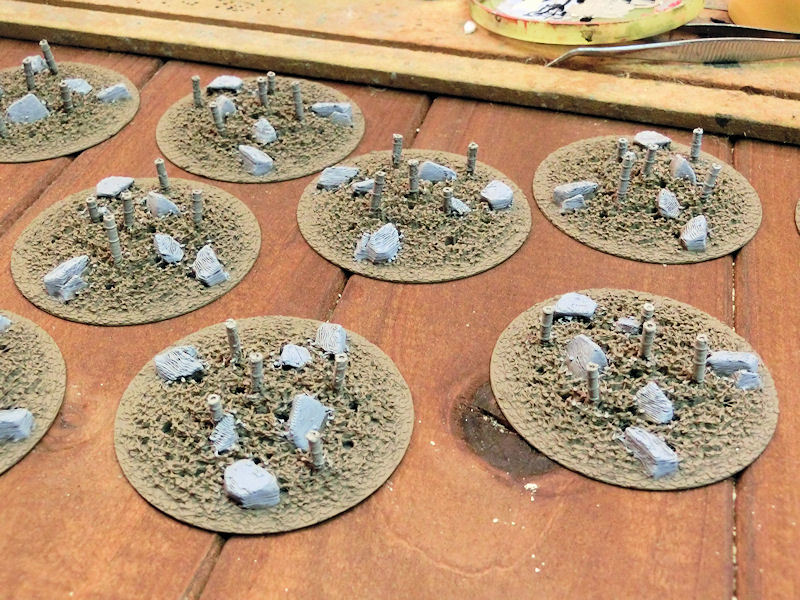
▲ I started the painting process with a light brown spray undercoat, and then light grey painted messily onto each rock. You don't need to be neat here, because later steps will hide mistakes!

▲ Next I covered each base in a heavy black wash, to fall into the crevices of the base.
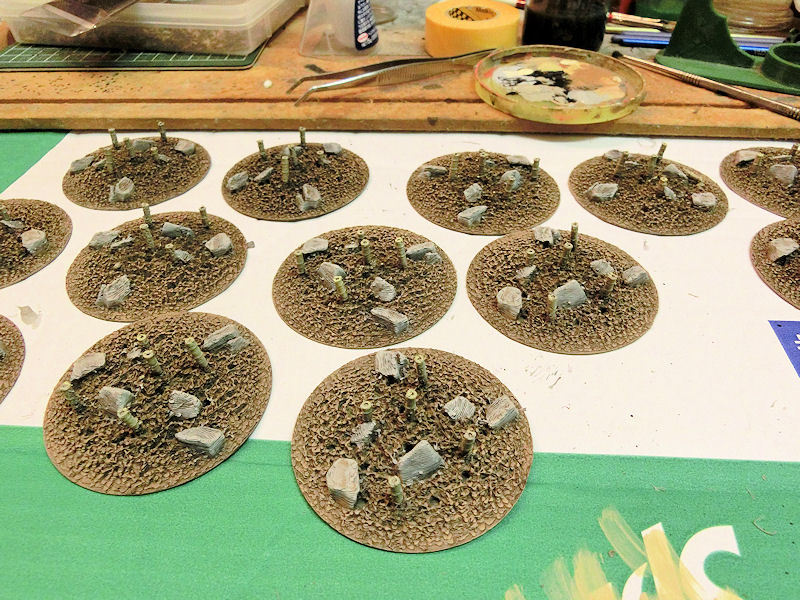
▲ Drybrushing was the final painting step, with a lighter brown for the earth, a light grey for the rocks, and a slightly different brown for the bamboo stalks. Be careful not to hit those stalks too hard, as they are fairly brittle at that size.
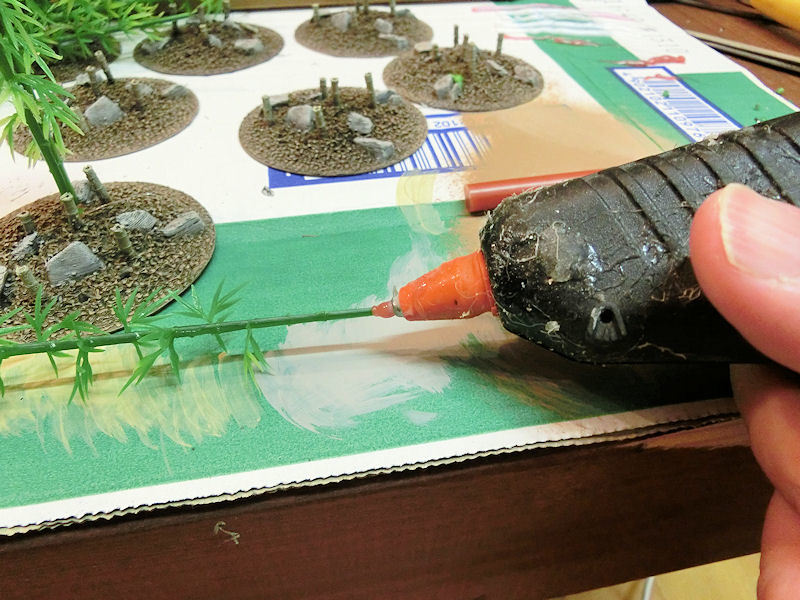
▲ Next I took my clippers, and snipped the bottom of each tree flat, so that it will fit the holes better. Then I grabbed my very old glue gun and dabbed a small blob of glue onto the end of each tree, before pushing it down into a hole. Start with the holes in the middle of the base, and stop adding trees whenever you're happy.
* Tip: I managed to find brown glue sticks for my hot glue gun (from the local 100yen store), which will look much better than blobs of white glue over each base.
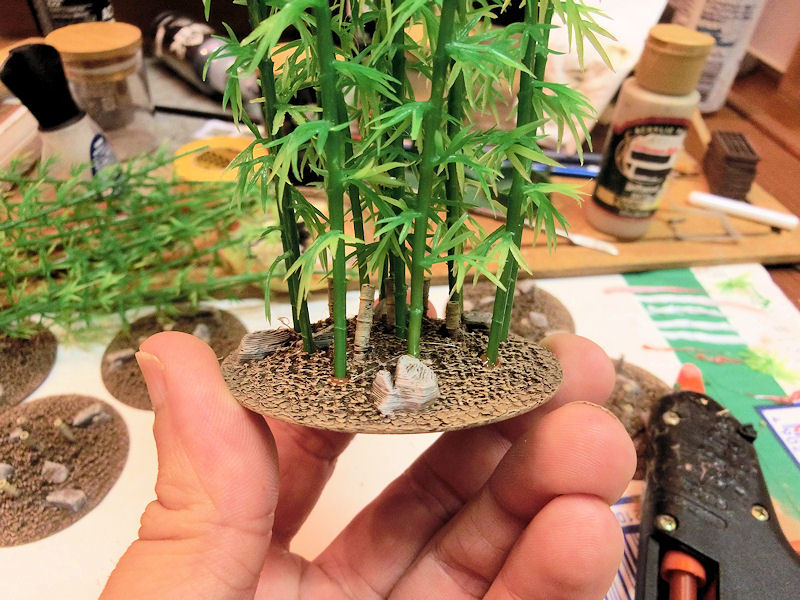
▲ Here's a base with several stalks of bamboo trees inserted. See how the brown glue is almost completely hidden? It's well worth getting a few sticks of brown glue if you can find them!
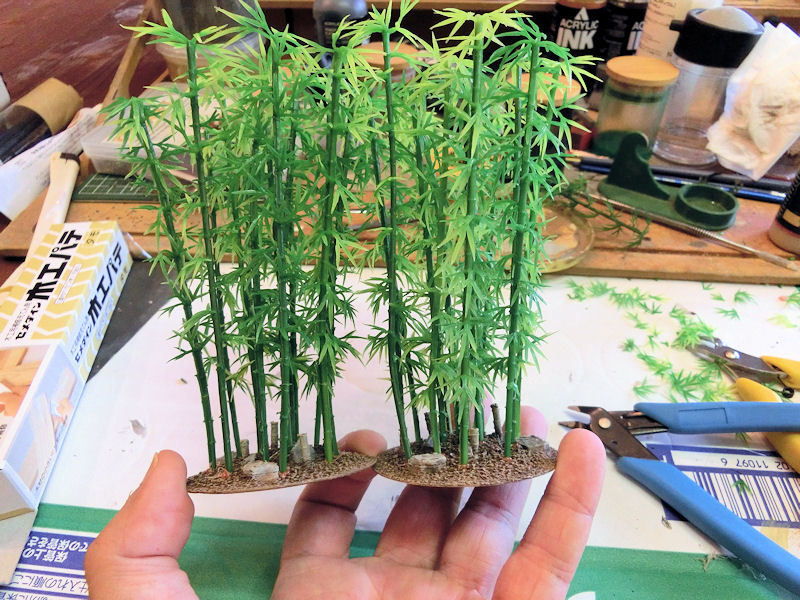
▲ Next I decided to trim the bottom couple of inches (about 5cm) of leaves from each base. This is probably not totally realistic (half of the tree height might look more real), but I wanted to keep some foliage lower down, to help block line of sight and make it look thicker. As long as the leaves start above head-height on a 28mm model, I'm happy enough.
The base on the left has been trimmed to remove lower leaves, as compared to the trees on the right, which are the uncut version. Only a small difference, but it looks better to me.
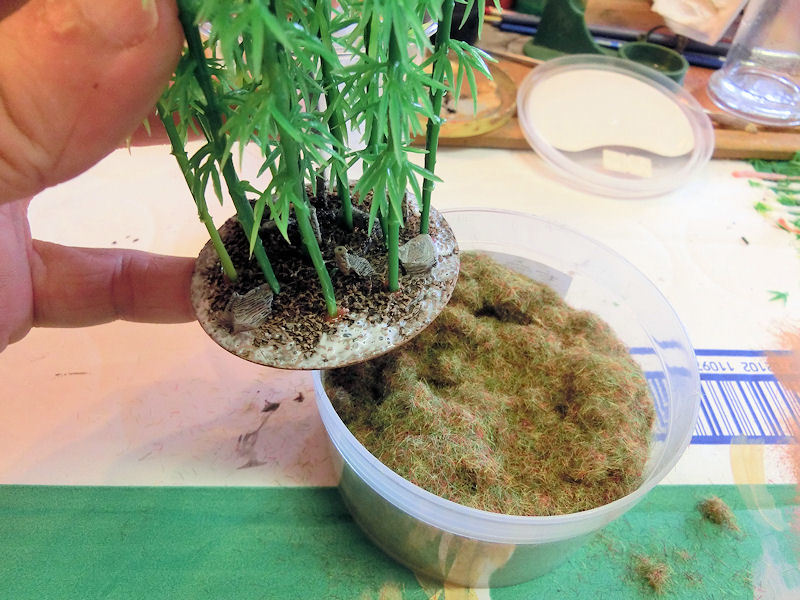
▲ The battlemat I'll probably use with this bamboo forest most of the time is a mid/dark green, so I wanted to blend the edges of each base to the mat. I used this darker green static grass around the edges, stuck down with very watery PVA glue.
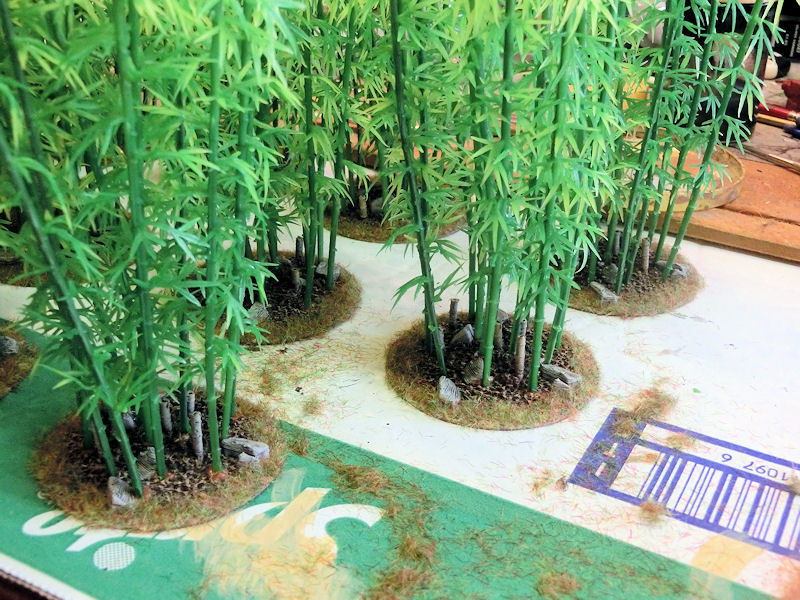
▲ When the glue had dried clear, each base looked pretty great. I'd happily use these on my battlefield.
HOWEVER, by this point I had already gone out and bought something to duplicate leaf litter on each base, so I might as well continue!
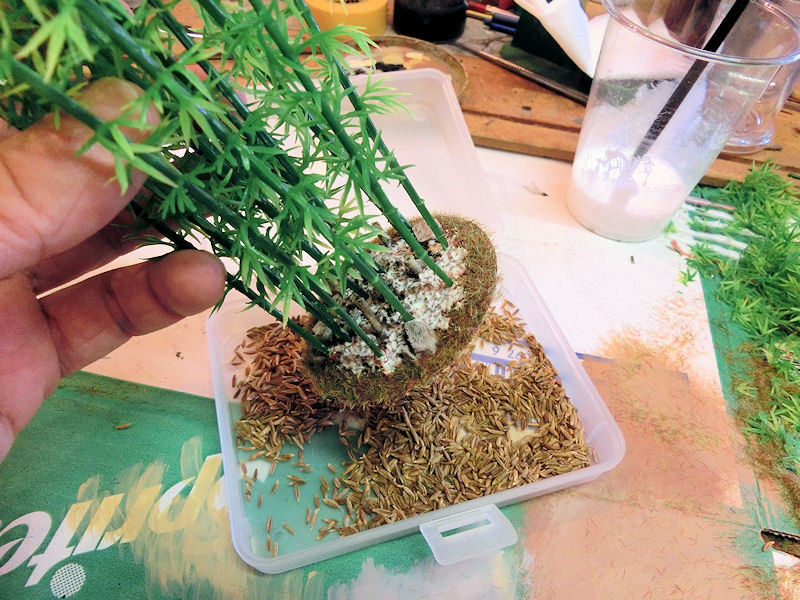
▲ I asked the wonderful group of people on the Facebook group Feudal Japanese Miniature Wargaming for suggestions on what might work at 28mm scale for bamboo leaf litter. First I tried a local tea shop for a bag of tea leaves in a suitable brown colour, but didn't find any good matches there. Rosemary leaves didn't have the right colour for me, but I was lucky enough to find cumin seeds in my local supermarket, which were a pretty good match in colour, size and shape. Thanks, Jim Jackaman, for the suggestion! Plus my bases had a lovely spicy smell for a couple of days!!
So I brushed some more watery PVA glue onto the centre of each base, amongst the trees, and sprinkled on the cumin seeds.
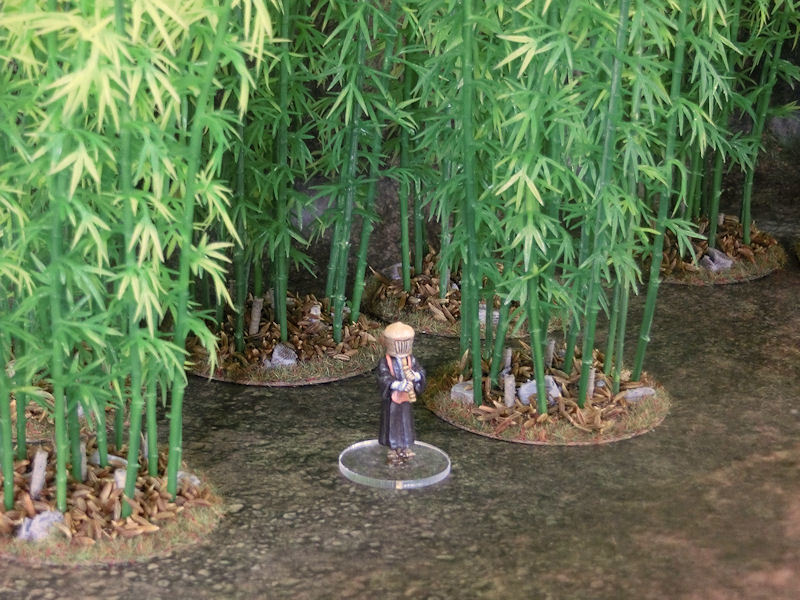
▲ This was the final result! With the bamboo leaves starting above head-height, each base is thick enough to visually look like a forest, and the floor has lots of interesting obstacles and detritus.
As a group they look great, but you'll have to wait a few more days until I can share proper photos of the completed shrine-in-a-bamboo-forest setting....
Today we have a new print partner to announce - SCALE 3D, from Wales. They are now selling print versions of our samurai terrain ranges at both 28mm scale AND 15mm scale.
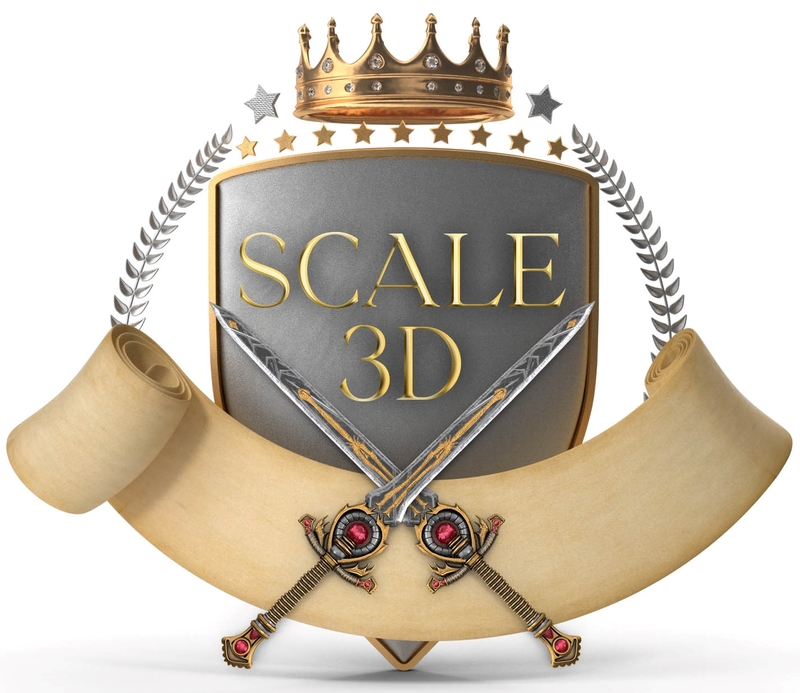
We have lots of great photos of the printed Shrine Set models to show you today, but first we're going to show you how to assemble the main shrine building.
Ready? Here we go....
▲ The base of the shrine building consists of this large stone base (included as a one-piece print, and also in 4 sections for smaller printers) surrounded by a wooden frame for the balcony. The balcony frame pieces print upside down, and don't require supports.
Note the gap in the frame, on the left side.
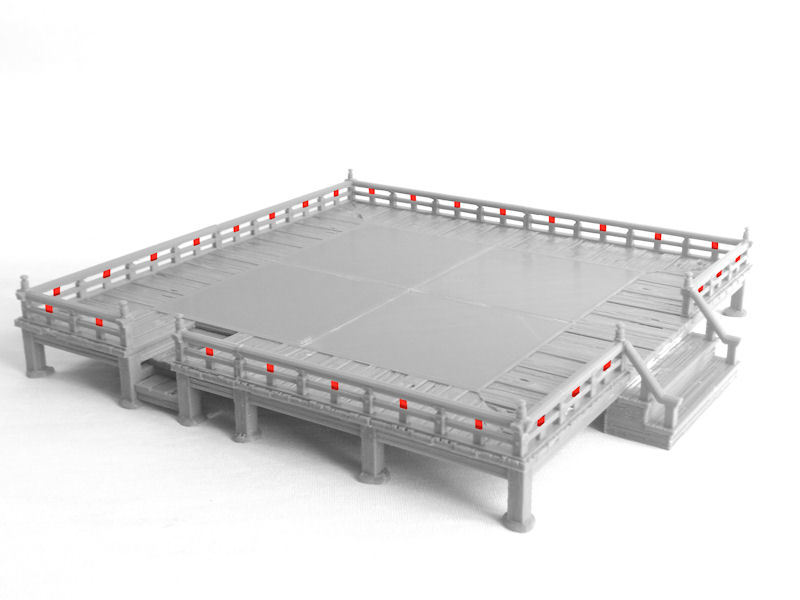
▲ Next you'll need to print the 4 sections of the balcony. In the photo above you can see that there are some built-in print supports marked in red. You can cut those out after printing, if you prefer, to make a more authentic shape of handrail.
After you've glued down the balcony sections, you should fit the wide steps at the front, and then the small steps at the side. Those are the 'backdoor' steps for the priests. You can finish the balcony off with 8 knobs at the corners, but those are optional.
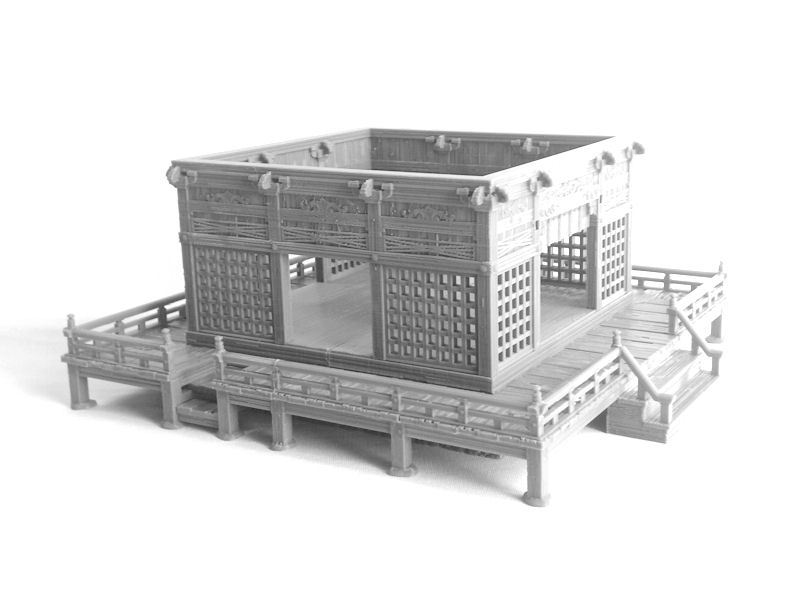
▲ Next comes the large floor for the building, which is printed in 2 halves. Then on top of that you can place the walls of the shrine building. If you have a larger print bed, I recommend printing the walls in one piece (upside down, so no print supports are required), but of course 4 separate wall pieces are also included for smaller printers.
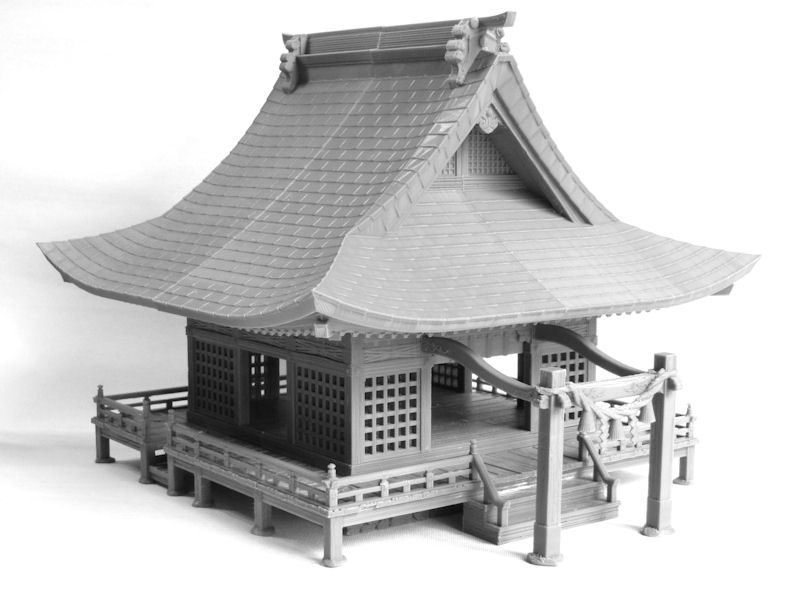
▲ Next we start building the front of the shrine, with two curved beams and the arch structure with rope tassles. You'll need to turn on print supports for those 3 pieces, to get the best results.
Then it's time for the big roof! That prints in 4 quarters. Please note that the roof quarters are quite large, and will require a print bed size of 141mm to fit each piece. Sorry about that! Everything else on the model can be fitted on a normal 125mm print bed.
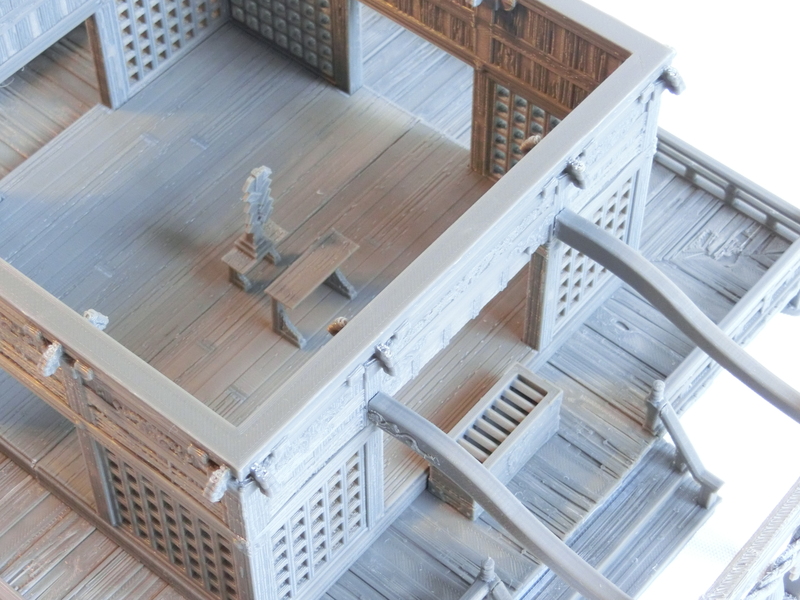
▲ We're almost done now! There are just a few finishing touches. First is the offering box in front of the curtained entrance, into which coins are dropped by visitors. Inside the shrine we find the simple wooden tables, onto which the paper tassled structure is glued.
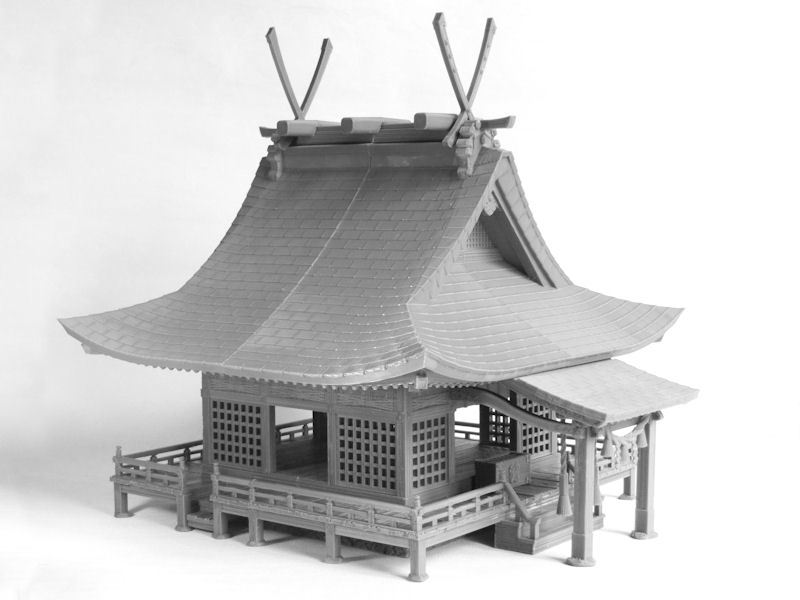
▲ To finish that front section, we need to print one last roof piece, which slots into place on top of those front posts. Two thick ropes with bells are hung from the underside of the front roof, and print supports are required for those pieces.
* Note: You can print the building without the front posts and front roof section, if you don't want to use it as a shrine. It could just be an awesome, fancy building!
The last parts needed to complete the shrine building are those extra roof decorations, which are simply glued into place on top. They are optional parts, so you don't need to add them if you prefer a simpler shape of building.
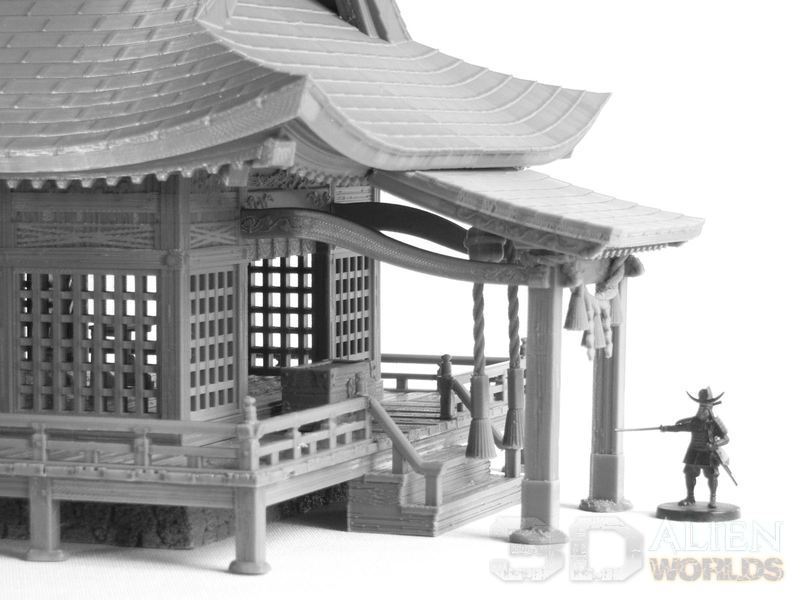
▲ That's it! The shrine building is complete! Isn't it HUGE?! Didn't those wooden carving details come out great?
But a shrine wouldn't be a shrine without lots of extra accessories, so let's take a look at those....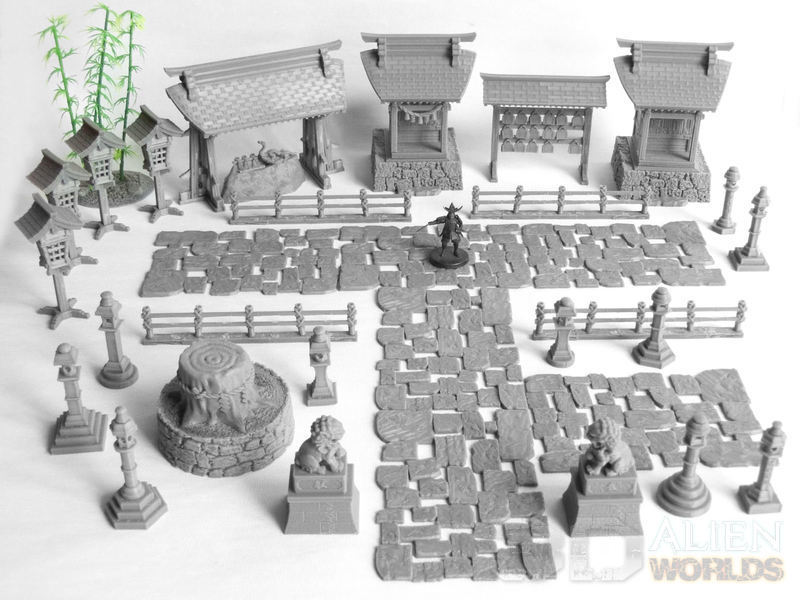
▲ Here's the full set of accessories included in the shrine set! There's probably enough here to cover a small gaming table. 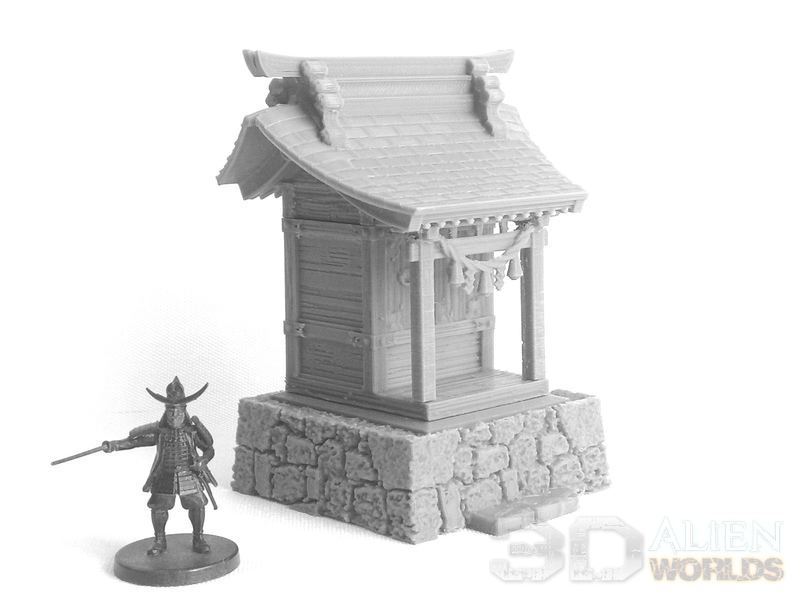
▲ We'll start with a look at the mini-shrine. This is a small auxiliary shrine, and is a very easy and quick print.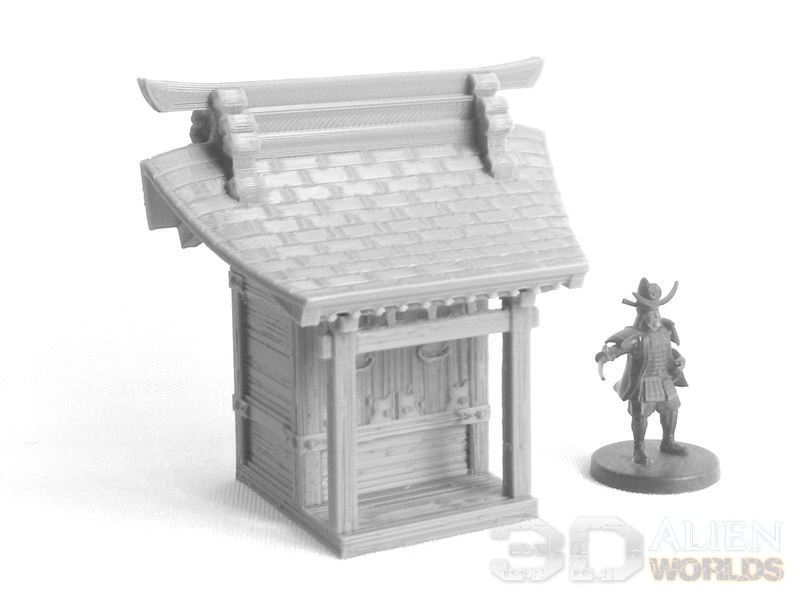
▲ You can also remove the mini-shrine from its stone base, if you prefer to make it smaller. This photo shows the version without the rope tassles at the front, and would make a great game objective (approximately 50mm at the base).
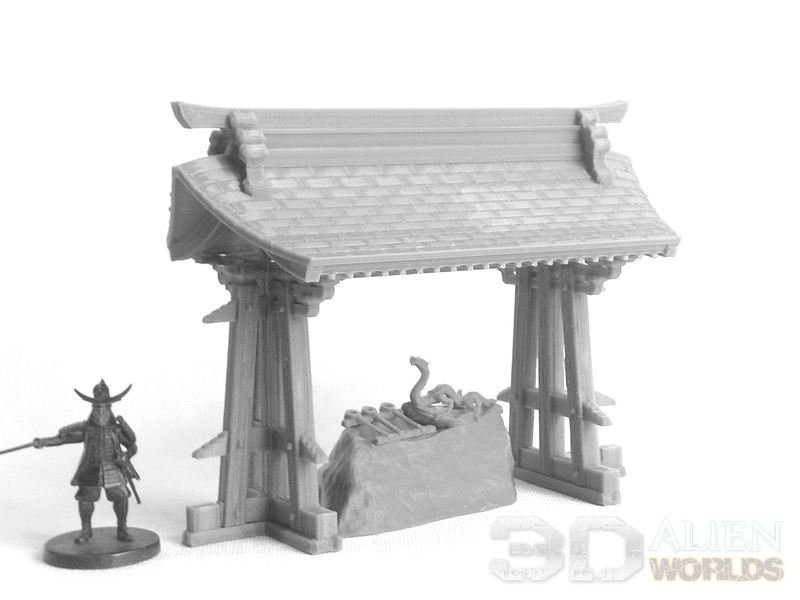
▲ This is the fancy handwash basin, which is found near the entrance to a shrine complex. This model also doesn't need supports, because the wooden frame prints upside down. I'm quite pleased with how well the bamboo water cups came out on my FDM printer, and also the lovely waterspout dragon on the rock. Sadly, I dropped it almost immediately, and snapped off a whisker!
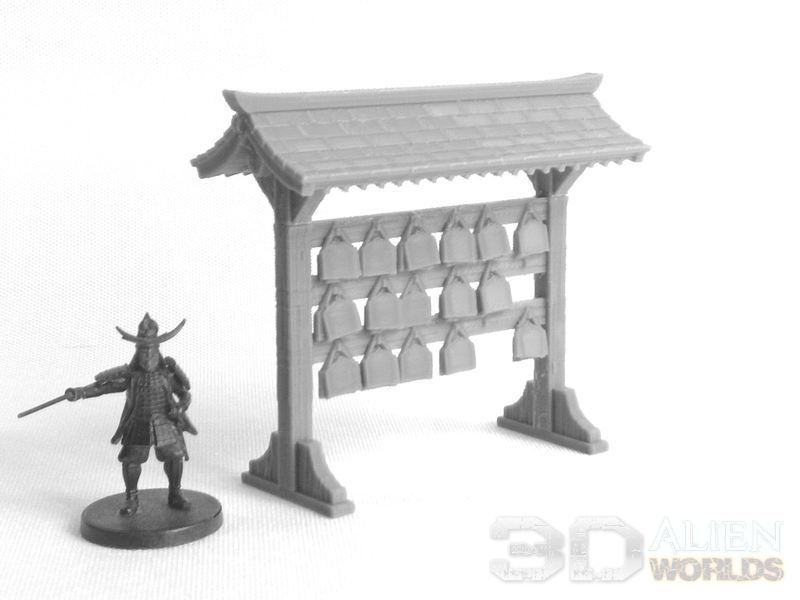
▲ Another essential piece of any Japanese shrine is this board of ema votive offerings. These are wooden boards onto which visitors will write their wishes (for good health etc), and then hung on the pegs.
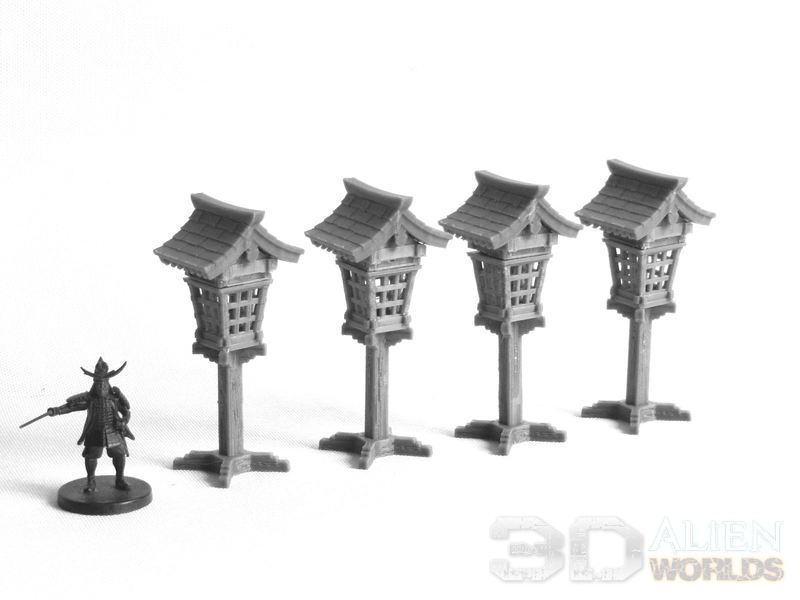
▲ In yesterday's blog we showed off this new shrine lantern design, and I printed 4 of them with the wooden base option.
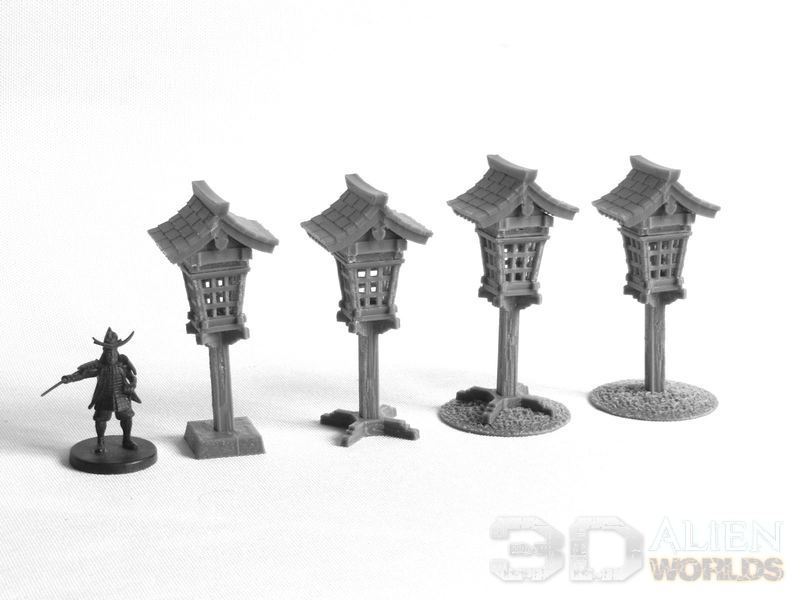
▲ There are actually 4 base options included in the set, as shown in the photo above.
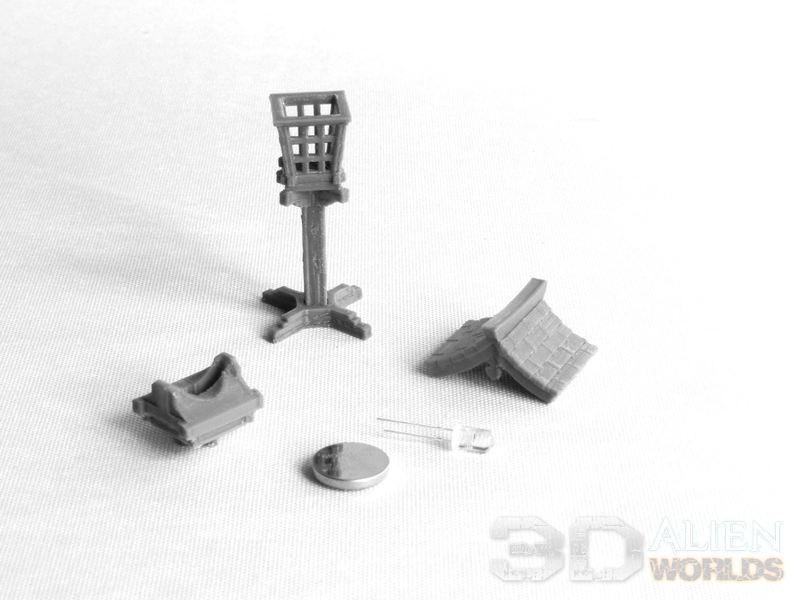
▲ The shrine lanterns can be fitted with a CR1632 coin battery and a small LED, to give a realistic glow to your gaming board.
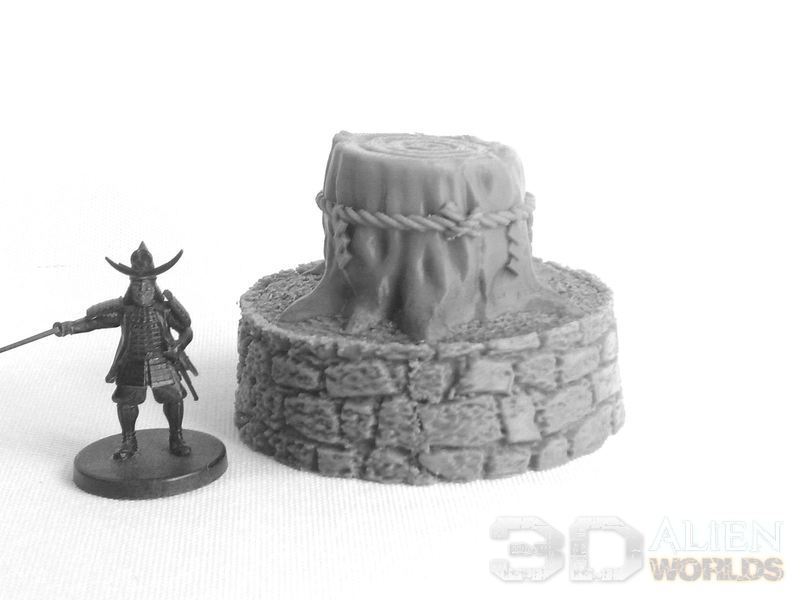
▲ This is the sacred tree stump, wrapped in a thick rope and paper tassles. These can often be found at Shinto shrines.
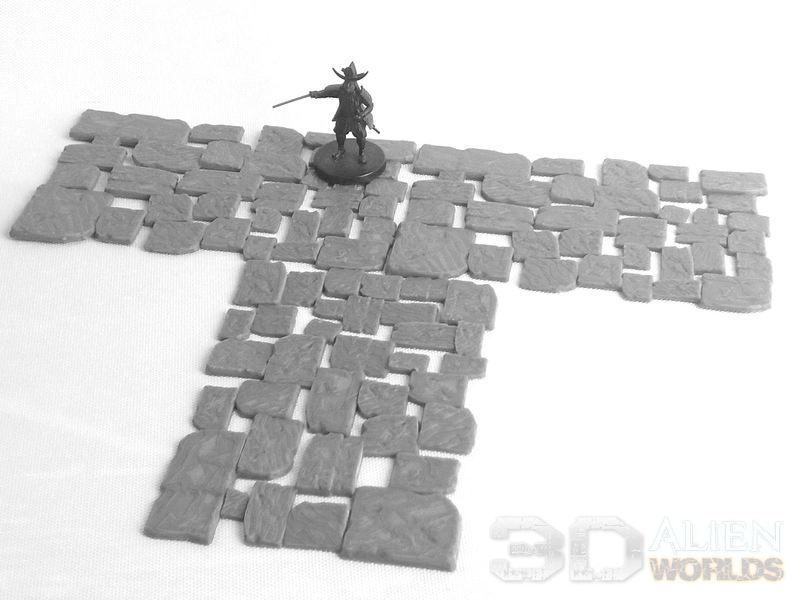
▲ The approach path to a shrine is usually made up of assorted stone slabs, worn smooth by the passage of feet over the years. These are easy prints, and can be used as straight paths and junctions in many samurai settings.
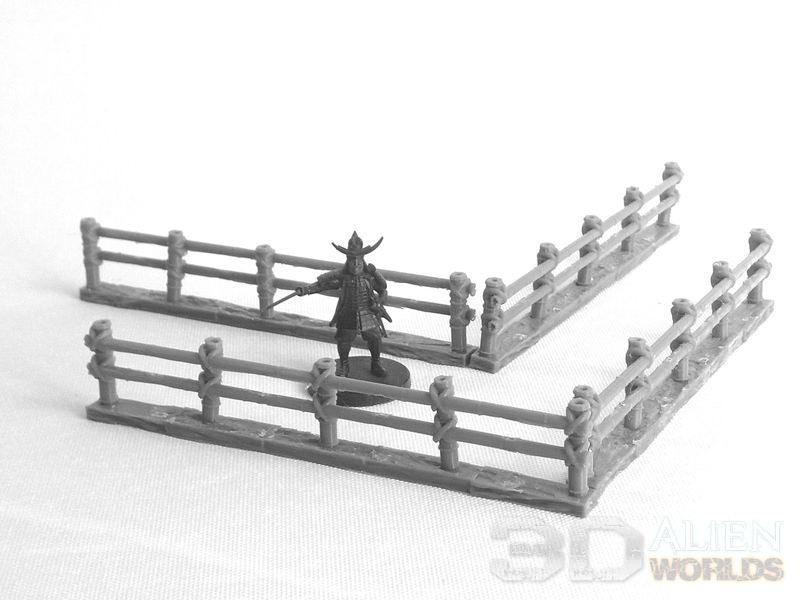
▲ Alongside the stone paths you'll often find simple bamboo fences, tied together by rough twine.
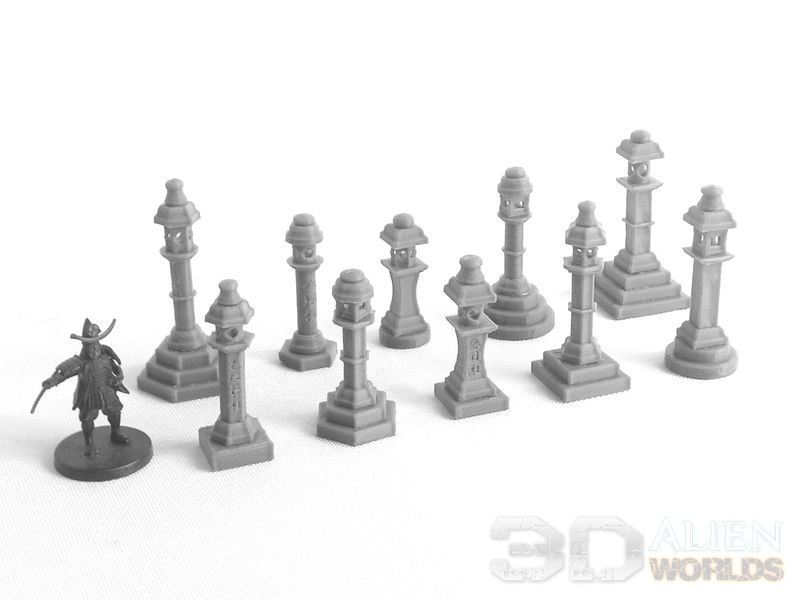
▲ At the sides of the path in a shrine you'll find many stone lanterns, in various shapes and sizes. These 10 lanterns were mixed and assembled from the contents of the ready-prepared set STL file.
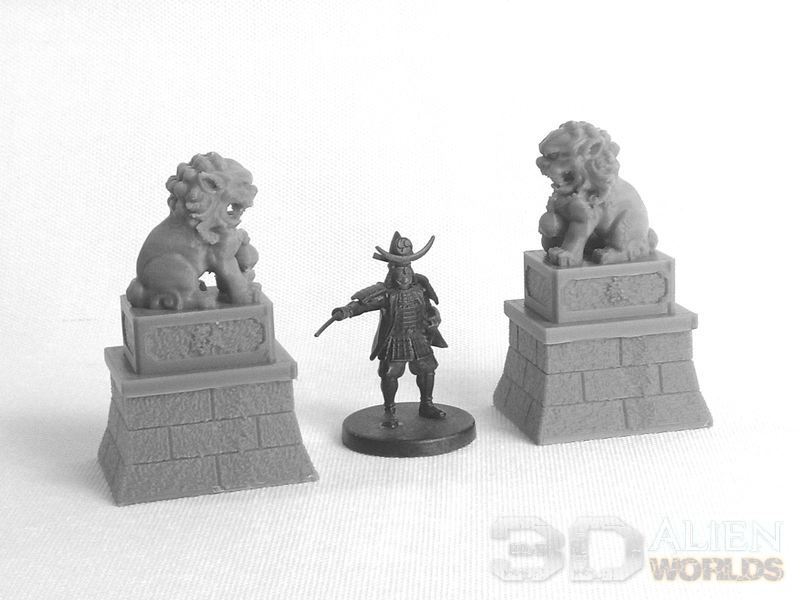
▲ This pair of komainu lion-dogs guard the entrance path to a shrine, and these are mounted on heavy stone plinths.
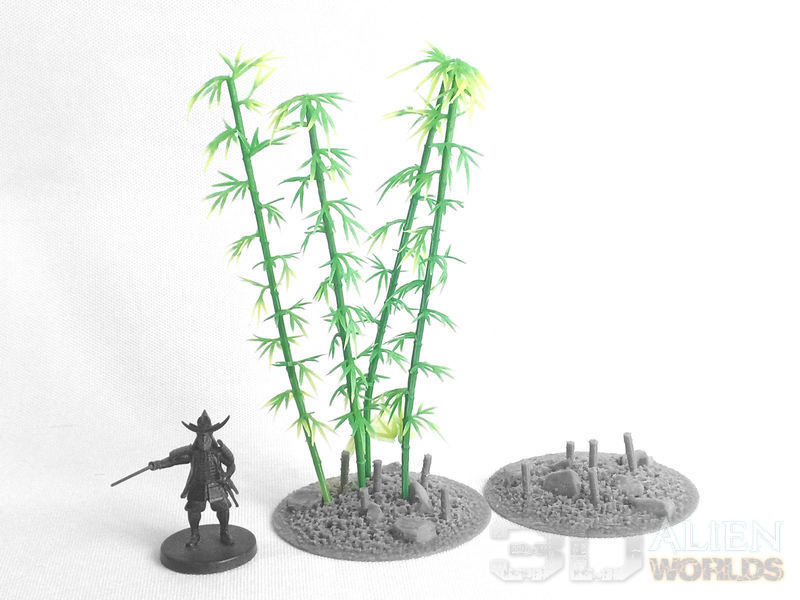
▲ Finally, we have this 60mm base for creating a bamboo forest to surround your shrine, into which you can insert these thin plastic bamboo trees. Please note that only the base is included in the set (shown in grey in the photo above). The green plastic bamboo trees are NOT included in the set, so you should grab some of those online!
Wow! It's a pretty big set, yes?
Please let us know what you think of everything, by sending us your comments below!
We've already had a couple of LED lanterns for the samurai range; the first was the streetside wooden lantern, and then the second was a rock lantern in the teahouse set.
Today we're taking a quick look at the new tall lantern from the upcoming Shrine Set!!!
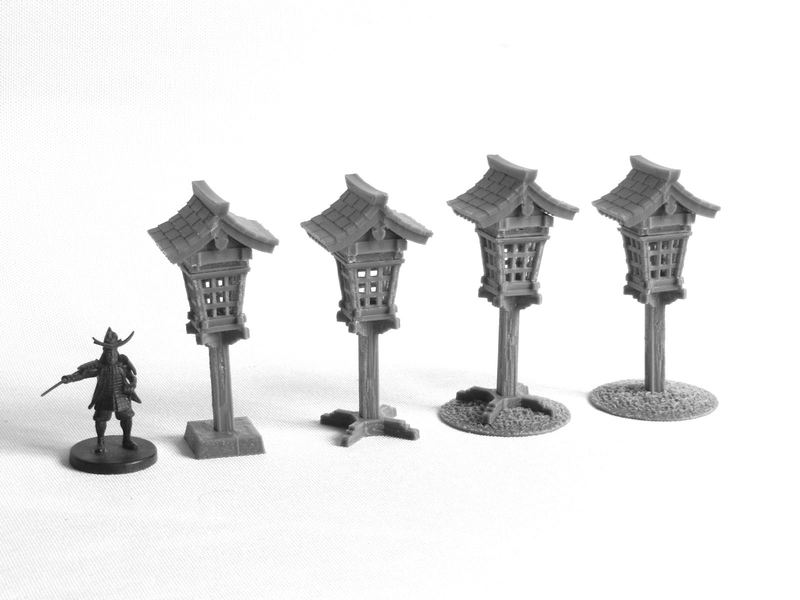
▲ First of all, you've got 4 different basing options for these lanterns! There's a neat stone base, a wooden X base, the wooden X on a 40mm round base, and finally a textured 40mm round base. You can choose whichever base suits your setting.
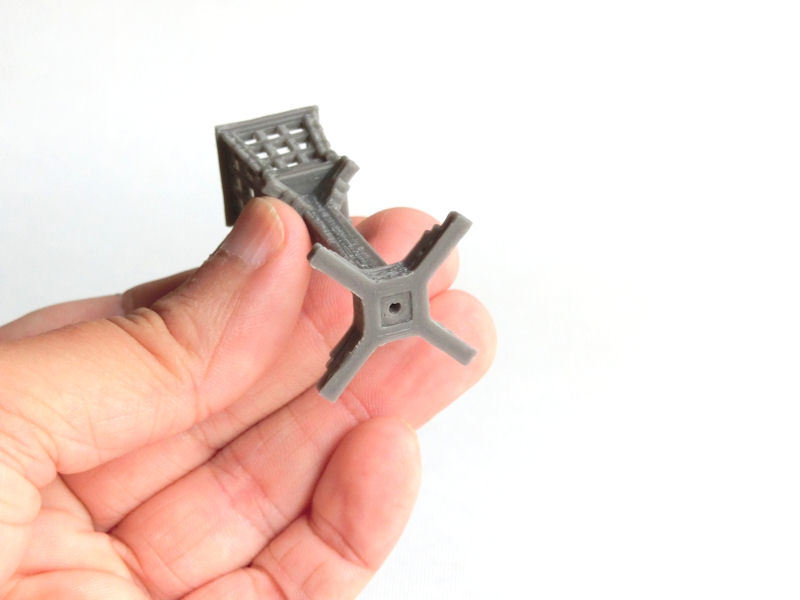
▲ For those of you who'd like to make a special permanent diorama, you can also permanently wire these lanterns into a fixed position on your board, and run a wire for LEDs up through the wooden post. A 2mm diameter hole has been built into the model from top to bottom, just in case you prefer that.
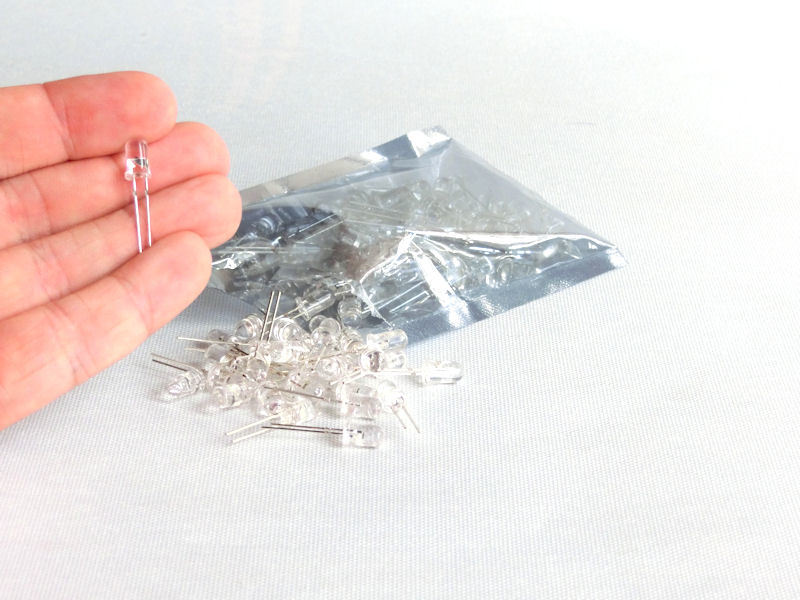
▲ So to wire an LED into these shrine lanterns, you'll need 2 things:
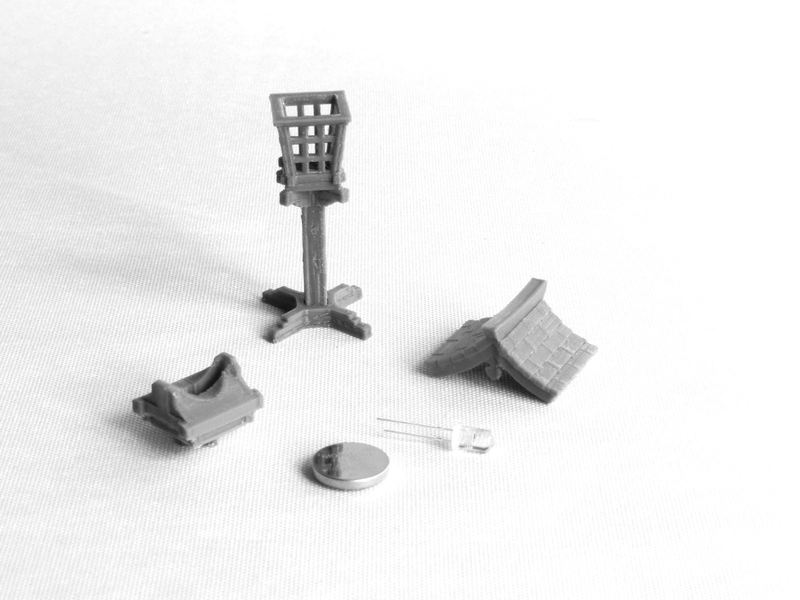
▲ That's it! Print your preferred base option, the lantern body (centre of the photo), a roof (right of the photo), and the battery holder (left of the photo). The battery holder section will need print supports enabled, but can actually also be printed upside down without any supports too!
Slide the LED's two wires through the holes in the bottom of the battery holder, push a battery into the top (it will only work in one direction), and slot the lantern pieces together.
Here's the quick video to show how easy this is....
Whoa! This new shrine set is turning out to be a biggie!! There's so much stuffed into the set that it could pretty easily cover an entire smaller gaming table, so let's take a look....

▲ First of all, let's show you the real-life shrine that this model is based on - Kokuzo Shrine, near the Aso volcano in Kumamoto Prefecture (happily, only a few minutes drive from the new studio!).
As you can see from the photo, it's a very old traditional wooden shrine complex, thought to have been originally created around 100BC. It was built to honour a truly massive cedar pine tree, that was finally toppled in a typhoon in 1991. The remains and roots of the tree have been preserved on site, and are well worth a visit if you're in the area - they are gargantuan!

▲ This shrine set is based around the large front building of the actual shrine, pictured at the rear of this CG render. The model features much of the wooden sculptures of the original, with carved sections and some awesome details.
Of course a shrine set wouldn't be complete without a whole bunch of extra structures, so let's take a look at a few of those now....
▲ This is an ema board. The ema are those little wooden plaques that visitors decorate with written wishes (good health, success in jobs or studies etc), and then hang on pegs on this rack, which is usually found near the main shrine building.
On the right we have a new lantern design! This one is specifically found on the approach roads/paths at shrines, and of course this version is designed to be fitted with an LED bulb and small battery!

▲ Near the entrance to every shrine there is a stone washbasin, where you briefly wash your hands to cleanse yourself before entering the shrine proper. This one is based on a real structure, and features quite elaborate wooden columns leading up to an even fancier version of the copper panelled roof.

▲ This minishrine is actually an auxiliary shrine called a sessha, and you'll often find one or two of these on the grounds of any decent-sized shrine complex. These make great little game objectives too, and I've included two versions of the front piece - one version with the fancy rope and paper tassles, and one version without.

▲ A variety of stone lanterns are often found on the approach path to a shrine, so there are a bunch of multipart ones included in this set. You've got round ones, square ones, hexagonal ones and curved ones, with three different heights of base too. Each shape version has a plain version and an engraved version, all gently textured with stone patterns.

▲ To make life easier for you, in addition to all the separate lantern section files, I've included this ready-prepared STL file of enough components to make 10 stone lanterns. It will fit on a standard 125mm print bed, and you can then mix and match to your heart's content!

▲ The path to a Japanese shrine is usually made from natural materials such as smooth paving stones or just dirt, so there is a 12cm x 8cm section of stone path included in the set. This is a one-piece print, only about 3mm high, and can be used in any orientation for paths, junctions and slopes.

▲ Along the sides of a shrine path you might also find a low fence, and this one is a waist-high 12cm straight section of bamboo and twine. The green bits in the pic above are built-in supports, and can be snipped out after printing. A non-supported version is also included.

▲ As a nod to the real Kokuzo Shrine, there is also a small sacred tree stump in the set, encircled with a thick rope and paper tassles. The actual cedar pine at Kokuzo Shrine is a massive 11 metres around, but this one is just a little baby by comparison! The base is 60mm in diameter.

▲ One of the smaller sacred trees at Kokuzo Shrine was raised up on a stone-edged base, and that inspired me to create this piece to fit the 60mm tree stump.
You could also use it to fit the 60mm base for cherry blossom trees, which is also included in the set.

▲ There's one other 60mm diameter base included in the shrine set - this bamboo forest base! Hidden amongst the rocks and bamboo are 14 small holes, into which you can glue those green plastic bamboo trees you can buy from online stockists - the trees themselves are not included in this set, because they're not very 3D printable, I'm afraid.
I'll be showing off just how to make the bamboo forests in a future blog article, which will hopefully make much more sense!
Watch this space for photos of the fully printed models (in just a few more days), when we can really show off all of the cool little details!
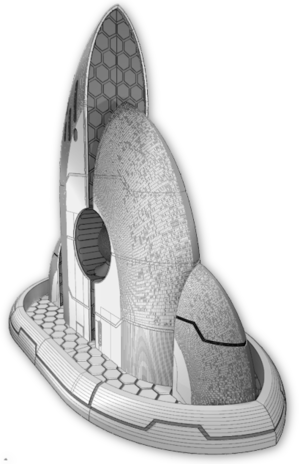
1 Comment :
NotQuiteDead
2024-06-17 (Mon) 5:09AM
Thanks for this tutorial. I'm currently making a bamboo forest using your bases, and I would never have thought of cumin seeds!
Write a comment :